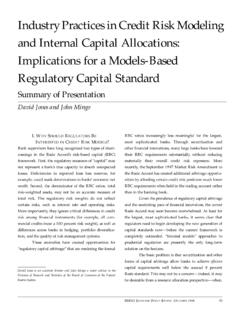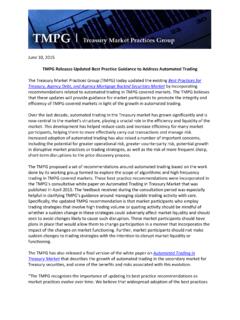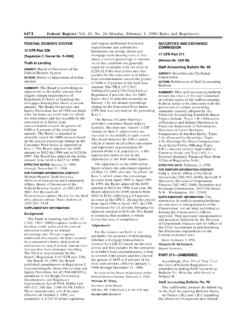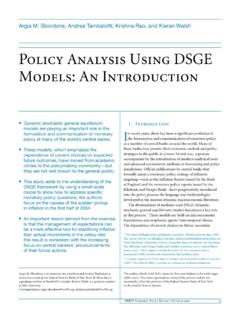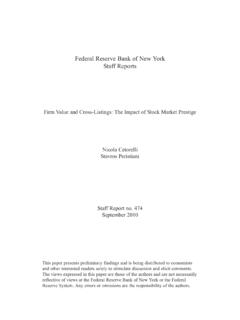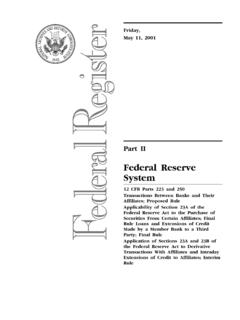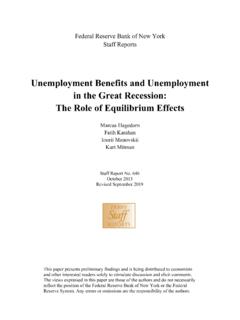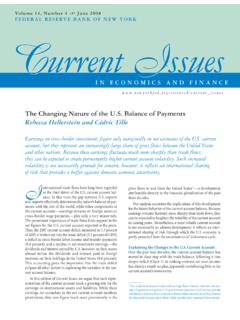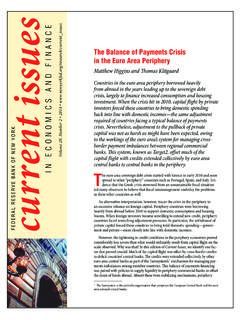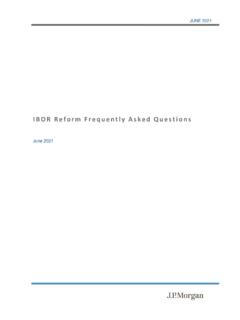Transcription of Forward Looking Term SOFR and SOFR Averages (Applied in ...
1 Forward Looking Term SOFR and SOFR Averages (Applied in Advance) Conventions for Syndicated and Bilateral Business Loans There are several forms of SOFR that parties in business loans may potentially choose to use, including Daily Simple SOFR in Arrears, Daily Compounded SOFR in Arrears, Forward Looking Term SOFR and SOFR Averages (Applied in Advance). In 2020, the ARRC published recommended In Arrears conventions for business loans. 1 In this note, the ARRC Business Loans Working Group focuses on the use of Forward - Looking term SOFR2 and SOFR Averages3 (to be applied in advance) for syndicated and bilateral business loans4. In both cases the interest rate is known in advance of the interest period, much like it is for LIBOR-based loans today, and thus most of the loan conventions can be similar to LIBOR loan conventions.
2 The recommended conventions identified herein address both new loans that are originated using SOFR and legacy loans that fall back from LIBOR to SOFR upon LIBOR cessation or LIBOR being declared to no longer be representative or if parties choose to utilize an early opt-in LIBOR transition trigger. As with all ARRC recommendations, these convention recommendations are voluntary and may not be applicable to all segments of the business loan markets. Each market participant should decide for itself whether and to what extent to use these recommended conventions in its transactions. It is also recognized that parties that wish to adopt the ARRC-recommended conventions may still need to make certain modifications so that they are administratively feasible in a particular transaction. New SOFR Loans SOFR Averages (Applied in Advance) vs Forward Looking Term SOFR The ARRC recognizes that syndicated and bilateral business loans may be based on the SOFR Averages or Forward Looking term SOFR ( Term SOFR ).
3 While the conventions on the two rates generally will be similar, the rates are provided by two different reference sources, reflect two different time periods, and use different day-count period conventions. 1 The ARRC published SOFR In Arrears Conventions for Syndicated Business Loans on July 22, 2020, available at The ARRC published SOFR In Arrears Conventions for Use in Bilateral Business Loans on November 25, 2020, available at 2 CME Term SOFR Reference Rates provide an indicative, Forward - Looking measurement of SOFR rates, based on market expectations implied from leading derivatives markets. More information is available at 3 The SOFR Averages are compounded Averages of the SOFR over rolling 30-, 90-, and 180-calendar day periods. For the purposes of these conventions, the applicable SOFR Average would be selected in advance of the interest period, and interest would be calculated on a simple basis.
4 4 The ARRC published SOFR In Arrears Conventions for Syndicated Business Loans on July 22, 2020, available at The ARRC published SOFR In Arrears Conventions for Use in Bilateral Business Loans on November 25, 2020, available at Reference Sources The SOFR Averages for 30, 90 and 180 days are published by the Federal Reserve Bank of New York ( FRBNY )5 . Parties may consider using the 30-Day Average for all tenor periods, as the shorter observation period ensures a more current CME Group Benchmark Administration Ltd currently7 publishes one-month, three-month and six-month Term SOFR Reference , 9 The benchmark can be licensed from CME Group and is available via CME DataMine, CME s Market Data Platform (MDP), and data redistribution partners such as Bloomberg and Refinitiv. Rate Publication Calendar SOFR is typically published every business day, including days for which SIFMA recommends an early close for secondary market trading of US government securities, but is not published on, or for, days for which SIFMA recommends a full closure.
5 In addition, the FRBNY may, with advance notice, choose not to publish its Treasury repo reference rates on any given business day if participants in the Treasury repo market broadly expect to treat that day as a holiday. The recommended convention is that the calendar referenced in credit agreements be US Government Securities Business Days with US Government Securities Business Days being defined as any day except for a Saturday, Sunday or a day on which the Securities Industry and Financial Markets Association recommends that the fixed income departments of its members be closed for the entire day for purposes of trading in US government securities. The publication of SOFR Averages follows the FRBNY publication schedule of SOFR. CME's Term SOFR Rates will be calculated for each day the FRBNY calculates and publishes SOFR.
6 Temporary Unavailability of Rate It is recommended that a temporary fallback convention be included in the event that either the SOFR Averages or Term SOFR (or the relevant tenor thereof) are not published for a short time. Such a convention may be the functional equivalent of: If as of [5:00 (New York time)] on any interest lookback day, the SOFR Average or Term SOFR has not been published by the relevant administrator or on the relevant administrator s website, then the rate used will be that as published by the relevant administrator or on the relevant administrator s website for the first preceding US Government 5 Available at 6 As an example, the 30-Day Average is being used in adjustable rate mortgages for six month interest periods. Because using a short-tenored SOFR Average, , 30-Day Average, for longer interest periods may increase the risk that the SOFR Average does not reflect current interest rates, parties could consider incorporating a margin adjustment for longer interest payment periods.
7 7 The CME has stated that a 12-month tenor rate is in development and will be added at a later stage based on the procedures established by CBA. 8 On May 21, 2021, the ARRC announced it had selected CME Group as the administrator that it planned to recommend for a Forward Looking SOFR term rate once market indicators for the term rate were met. Press release available at 9 Available at Securities Business Day for which such rate was published on such administrator s website so long as such first preceding US Government Securities Business Day is not more than three (3) US Government Securities Business Days prior to such interest lookback day. Alternatively, some parties may prefer to use interpolation in the event of any temporary unavailability of any tenor the benchmark, however, use of interpolation is dependent upon the operational capabilities of the sole lender or administrative agent, as applicable.
8 Holiday and Weekend Convention The recommended convention for both SOFR Averages and Term SOFR is for holiday/weekends to be any day that is not a US Government Securities Business Day. Lookback For both SOFR Averages and Term SOFR, the recommended convention is to use the rate published two US Government Securities Business Days prior to the first day of the interest period and held for the entirety of the interest period, similar to the LIBOR convention today. Borrowing Notice Period For both SOFR Averages and Term SOFR, the recommended convention is for the borrower to provide notice of a borrowing request three US Government Securities Business Days prior to the borrowing date, similar to the LIBOR convention today10. Length of Interest Periods May Not Be Equal to SOFR Average Observation Period or Term SOFR Tenor SOFR Averages are based on number of calendar days rather than number of months, , 30/90/180 days; however, a SOFR Average can still be used for interest payment periods based on number of months.
9 The number of days used for the applicable SOFR Average may not be directly related to the length of time for the interest payment period (see Reference Sources and Footnote 6 above), , 30-Day Average SOFR may be used for a one-month interest period or other interest periods. CME's Term SOFR Rates are published as one-month, three-month and six-month Forward Looking term rates, similar to the LIBOR convention Daycounts The recommendation is Actual/360 days for Term SOFR and SOFR Averages , which is the standard convention in US money markets; however, it is possible to use other day-count fractions ( , Actual/365 days.). 10 Bilateral loans may have more flexibility in borrowing notice periods. 11 For interest periods for Term SOFR that do not match one-, three- or six-month periods, parties can either use the next closest rate or interpolate between the two closest rates.
10 The ARRC acknowledges that not all lenders, borrowers and systems have the ability to interpolate, so recognizing any party s limitation may be important when choosing which convention to use. Parties may consider using Term SOFR tenors that are comparable to the interest period, to account for minor variations, including variations that occur as a result of business day conventions. Business Day Convention The recommendation for SOFR Averages and Term SOFR is to follow the Modified Following Business Day convention, meaning that payments that are scheduled to be paid on a day that falls on a non-Business Day will be adjusted to the next succeeding business day, unless that business day falls in the next succeeding calendar month, in which case the interest payment date will be the preceding business day.
